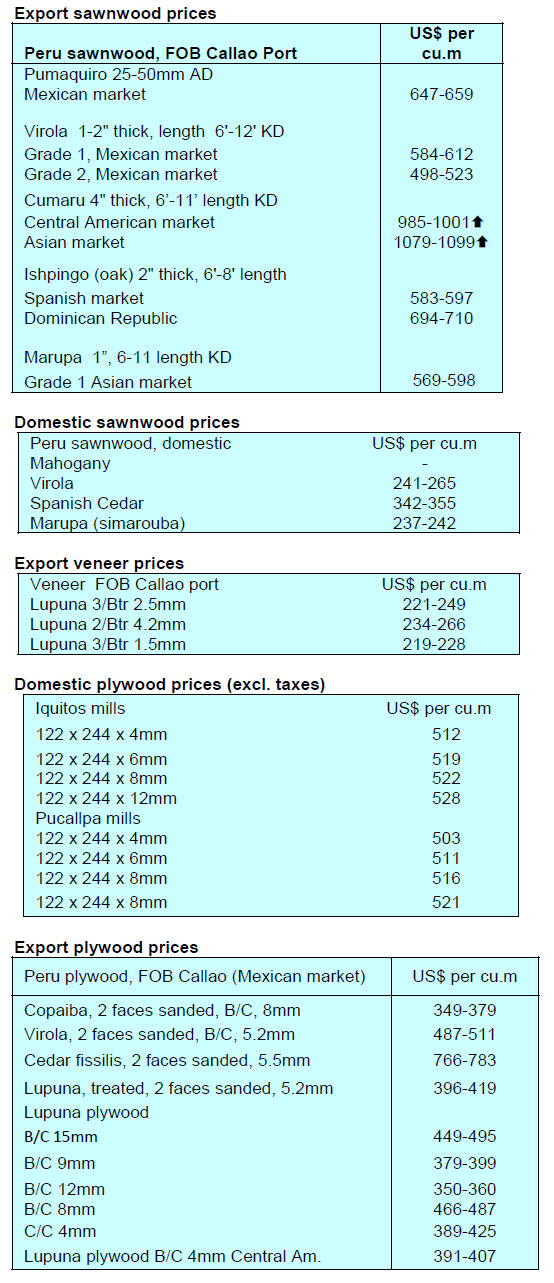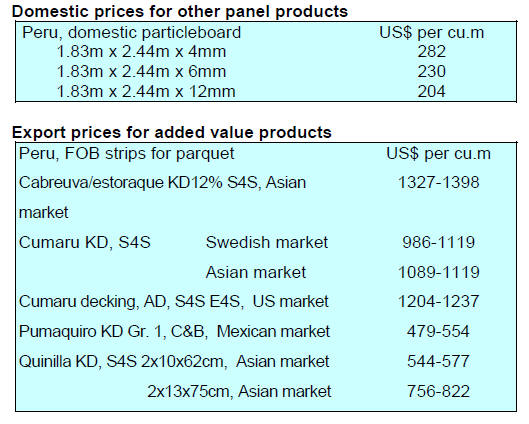2.
GHANA
2020 exports declined in volume and value
Ghana’s exports of wood products in 2020 dropped to
226,158 cu.m representing a 25% year on year decline
compared with 2019. The export earnings for the year
were down 23% to Eur116.15 million in 2020 from
Eur300.455 million in 2019.

Air and kiln-dried sawnwood accounted for 66% of total
export volumes in 2020 but air dry sawnwood exports
were down 36% and kiln dry sawnwood exports fell 26%.
However, an increase in export in volumes was recorded
for rotary veneer (up 23%), air-dried boules (up 13%) and
mouldings (up 9%).
Overal,l export revenues plummeted but there were some
gains recorded for rotary veneer, mouldings, billets, airdried
boules and plywood for regional markets but
combined these products accounted for only 25% of total
2020 exports.

Direction of trade
Ghana’s wood product trade was largely with Asian
markets which accounted for over 60% of total exports in
2020. However, this was about 7% below levels seen in
2019.
The key markets were India, Vietnam, China and United
Arab Emirates. The major products were billets (plantation
logs) and sawnwood.
Wood product exports to Europe accounted for almost
19% of 2020 exports compared to 16% in 2019 and
included sawnwood, veneers, moulding, boules, plywood,
kindling and briquettes. The key markets were Germany,
Belgium and United Kingdom.
Neighbouring country wood products imports from Ghana
increased from 11% of all exports in 2019 to13% in 2020.
The ECOWAS market (mainly Senegal, Nigeria, Niger,
Gambia, Mali, Benin, Burkina Faso and Togo) accounted
for 83% of the volume of exports. Plywood and rotary
veneer dominated exports to ECOWAS member countries.
Ghana to benefit from EU funded mangrove project
Ghana is to benefit from an EU funded four-year project
on the management of mangrove forest that seeks to
protect mangroves in selected African countries from
Senegal to Benin.
The project aim is to strengthen the management of
protected and unprotected mangrove sites in these
countries.
National forest and land use map
The Ghana Forestry Commission has launched a National
Map of Forests and Land Use the culmination of a threeyear
project supported by Forests 2020, managed
by Ecometrica and supported by the UK Space Agency’s
International Partnership Programme.
See:
https://www.geospatialworld.net/news/national-map-offorests-and-land-use-by-ghana-forestry-commission/
Ghana recipient of COVAX vaccine
In a press release the UNICEF Representative in Ghana,
Anne-Claire Dufay and WHO Representative to Ghana,
Dr. Francis Kasolo announced the arrival of the first
COVID-19 vaccines in Ghana.
The shipment, consisting of 600,000 doses of
the AstraZeneca vaccines, arrived at Kotoka International
Airport in Accra. The Minister for Health-designate,
Kwaku Agyeman-Manu, led a government delegation to
receive the consignment.


3. MALAYSIA
Vaccine
roll-out scheduled
The pandemic is still disrupting life and businesses in
Malaysia but the government expects to complete its
vaccination programme by February next year covering
80% of its population of about 32 million people.
The first phase of the vaccine rollout is from February and
will involve 500,000 frontline workers followed by 9
million high-risk individuals who will be vaccinated
between April and August. A third and final phase will
involve more than 16 million adults aged 18 and older.
The country has seen a sharp spike in corona infections in
recent weeks after having largely reigned in the epidemic
for most of last year. The surge in cases has pushed the
cumulative total above 220,000.
2020 timber industry performance
The Malaysian Timber Industry Board (MTIB) has
reported last year’s performance of the timber sector.
Exports were RM 22.02 bil (RM 22.50 bil in 2019) while
total imports were RM 6.81 bil (RM 5.95 bil in 2019).
Timber exports contributed 2.2% of the country’s overall
exports of RM 980.99 bil. The workforce in the forestry
sector was estimated at 140,000 of which 55% are
estimated to be foreign and 45% local. Annual investment
data are available only for 2019 showing domestic
investments were RM 479.88 mil and foreign investments
RM 851.42 mil.
Exports in the first quarter 2020 were badly impacted by
measures to address the Covid-19 pandemic though timber
companies were later allowed to operate with a 50%
reduction in manpower. The industry faces a shortage of
raw materials both domestic and imported. Moreover,
from July ocean freight rates for containers increased
sharply and the situation was made worse by disruption in
container availability.

The industry suffered from a shortage of and sustainable
supply of raw materials. Marketing was made more
challenging with the US Lacey Act, Australia’s Illegal
Logging Prohibition Act, the EUTR and the California
Anti Deforestation Act. Also, there was stiff competition
in pricing and quality from neighbouring Indonesia and
Vietnam.
E-commerce became more common during the Covid 19
pandemic and this was a challenge as not all products can
be sold in e-markets. The heavy reliance on foreign labour
is of concern though there seems to be no clear path to
address this.
There is a severe lack of skilled workers as can be seen by
the low productivity. The timber sector worker
productivity is about RM 47,000/worker/year while the
national average is RM 77,000/worker/year. Overall there
seems to be a lack of innovation in wood products and
original designs.

Shipping a major headache
The timber industry is experiencing a disruption of
container flows. Some shippers are keeping their
containers longer than usual and an imbalance between
exports and imports in some major trading countries has
caused surpluses in some ports and shortages in others.
Westports Holdings managing director, Ruben Emir
Gnanalingam, pointed out that, due to slow retail sales
because of the lockdowns, many companies have stored
packed containers and only when sales pick up can the
containers be unstuffed and put back into circulation. He
said under normal circumstances the container shipping
cycle averages about five to six shipments globally per
annum. However, container shipments take much longer
now and the cycle has dropped to between four and five
because of the pandemic.
See:
https://www.nst.com.my/business/2021/02/667840/containershortage-due-shippers-keeping-longer-expected
Attracting engineers and technologist to the timber
industries
A press release from the Malaysian Timber Council
(MTC) introduces its first ‘Engineer Placement and
Internship in the Timber Industry Programme’, a move to
attract engineers to the timber sector.
The programme will begin in March and is aimed at
engineers, wood technology graduates as well as
undergraduates who will be invited to join timber
companies for an internship that may lead to them building
successful careers in the industry.
The MTC internship programme will be a collaboration
between the Council, companies, higher learning
institutions and timber associations. MTC CEO, Muhtar
Suhaili, says the need for engineers is becoming more
crucial as timber-based manufacturers remodel their
operations towards digitalisation and smart manufacturing
He added that this programme is part of the MTC’s Five-
Year plan which focuses on building the knowledge talent
in the industry.
See:
http://www.mtc.com.my/media-PressRelease.php
4.
INDONESIA
Indonesia’s exports of wood products
better than
expected in 2020
Indonesia’s exports of forest and wood products to all
destinations held up better than expected in 2020.
According to a statement in January 2021 by Bambang
Hendroyono, the Secretary General in the Indonesian
Ministry of Environment and Forestry, Indonesia’s 2020
export target for forest and wood products was projected
to be exceeded despite the impact of the corona pandemic
on production and trade.
Early in 2020 the export target was lowered from US$10
billion to US$7 billion to take account of the anticipated
disruption of business. However, export earnings in 2020
are expected to exceed US$11 billion, even more than the
original target and only 5% below that of 2019. The
Secretary General emphasised that Indonesian
Government incentives and relaxation of regulations
helped achieve this success.
Indonesian forest products export data can be found at:
https://www.flegtimm.eu/index.php?view=article&id=275:indonesia-sexports-of-forest-and-wood-products-better-than-expected-in-2020&catid=21:market-news
With growth in January 2021 of 6.3% compared to
January 2020 prospects for the year look positive. The
strongest growth in terms of export value was by the
furniture sector. Reacting to the positive growth level
attained by forestry exports in January the Association of
Indonesian Forest Entrepreneurs (APHI) Chairman,
Indroyono Soesilo, said he anticipates 2021 export
earnings by the forestry sector will be US$2 billion.
See:
https://foresthints.news/indonesias-forestry-exports-moveback-to-positive-growth/
Finland an appreciative market for teak products
According to a press release from the Indonesian Embassy
in Helsinki, Ambassador Ratu Silvy Gayatri has seen that
teak furniture made in Solo and Yogyakarta has found a
market in Finland.
A furniture store operator in Finland said "Indonesian
furniture is known for using high quality wood and unique
designs, which the Finnish people appreciate."
The Ambassador has been promoting furniture products
made by Indonesian micro, small and medium enterprises
to support improve the export performance.
See:
https://sinarjateng.pikiran-rakyat.com/internasional/pr-1001474366/dinilai-unik-furnitur-indonesia-punya-banyakpeminat-di-finlandia
President urges early preparation for forest fire season
The Indonesian President has urged local authorities to be
prepared to tackle forest fires later this year highlighting
growing risks in Sumatra, Kalimantan and Sulawesi. The
high risk period begins in May and peaks in August to
September. The President said fires cause considerable
financial losses and serious damage to the ecosystem.
As most fires are caused by human activity the President
stressed that the law should be applied without
compromise and anyone who sets fire to forests will face
the full weight of the law.
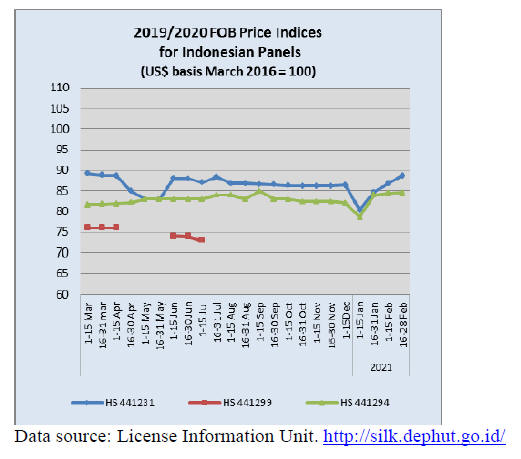
5.
MYANMAR
Civil Disobedience
Movement – businesses closed
After the military-led State Administration Council took
control of government on 1 February 2021 employees
from the private sector, along with government employees,
have joined the Civil Disobedience Movement in protest.
This resulted in almost all business ceasing operations and
exports. Only those containers stuffed before 1 February
have been shipped. The Myanma Timber Enterprise
suspended the monthly tender sale.
Priority for Economic Recovery
The new Minister of Investment and Foreign Economic
Relations of the State Administration Council outlined
plans for economic recovery in the aftermath of COVID-
19.
See:
https://www.mmtimes.com/news/myanmar-prioritiseeconomic-recovery-says-minister.html
Threat of sanctions a risk for businesses
Many firms, especially foreign-owned businesses in
Myanmar have reacted with shock to the declaration of a
yearlong state of emergency.Dr. Maung Maung Lay, vice
chair of the Union of Myanmar Federation of Chambers of
Commerce and Industry (UMFCCI), told The Irrawaddy
newspaper many investors are in shock over the military
takeover adding that businesses are waiting to see how the
situation unfolds.
Economist Dr. Aung Ko Ko said the military takeover
would impact small and medium-sized enterprises in the
country and jeopardise the economic reforms implemented
by the civilian government.
See:
https://www.irrawaddy.com/news/burma/sanctions-threatalready-chilling-effect-business-activity-myanmar.html
Running short of cash
A growing number of businesses reported that they are
running short of cash with banks closed. Most banks in the
country have been unable to open for business as
employees failed to report for work in order to participate
in the nationwide protest. Almost all 27 national banks
have been closed for the past two weeks.
See:https://www.mmtimes.com/news/myanmar-businesses-callstability-banking-sector.html
World Bank - Myanmar’s development prospects
threatened
In a statement on its website the World Bank says the coup
threatens Myanmar’s development prospects. The
statement dated 19 February reads:
“The World Bank Group is gravely concerned about the
ongoing situation in Myanmar following the events of
February 1, which constitute a major setback to the
country’s transition and its development prospects.
Effective February 1, we have temporarily put a hold on
disbursements on our operations in Myanmar, as we
closely monitor and assess the situation. The World Bank
Group’s internal policies and procedures lay out processes
in these situations which we are following carefully.
We are putting in place enhanced monitoring of projects
that are already underway, to ensure compliance with
World Bank Group policies.
For the last decade, the World Bank Group has been a
committed partner in supporting Myanmar’s transition to
democracy, and its efforts to achieve broad-based
sustainable growth and increased social inclusion. We
remain firmly committed to these goals and to the
development aspirations of the people of Myanmar.”
See:
https://www.worldbank.org/en/news/statement/2021/02/01/developments-in-myanmar
6. INDIA
Wood product price
indices rise
The Ministry of Commerce and Industry has reported the
official Wholesale Price Index for ‘All Commodities’
(Base: 2011-12=100) for January 2021 increased to 124.0
in January from 123.0 in December 2020.
The index for manufactured products increased in January
2021. 18 groups saw increased prices including furniture,
paper and paper products, wood and of products of wood
and cork compared to December, 2020. The rate of
inflation based on monthly WPI stood at 2.03% in January
2021 compared to 3.52% in January 2020.
The press release from the Ministry of Commerce and Industry
can be found at:
http://eaindustry.nic.in/cmonthly.pdf
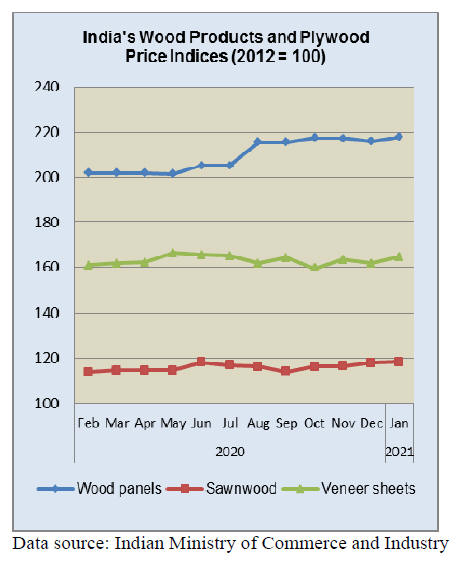
Encouraging export growth
India recorded a 6% surge in exports in January, the
second monthly improvement since the beginning of the
pandemic. Imports also grew for the second successive
month in January, rising 2% according to the Indian
Ministry of Industry and Commerce.
Supreme Court – foregone benefits from tree clearing
to be included in development project costs
Chief Justice SA Bobde of India’s Supreme Court's Green
Bench has declined to approve tree felling in the Taj
Trapezium Zone, an area of 10,400 sq. km around the Taj
Mahal. The court ruling says felling of mature, beneficial
trees for development work, including laying roads and
setting up industries is banned. The court further ordered
the inclusion of the value of trees, such as its oxygen
production, to be included in the project cost.
See:
https://www.hindustantimes.com/india-news/sc-puts-onhold-felling-of-trees-for-road-projects/story-NijChv0l4f9qgvj9N18A6N.html
(On April 16,1996, a division bench of the Supreme Court (SC)
comprising Justices Kuldip Singh and S Saghir Ahmed directed
the chief justice of the Calcutta High Court to constitute a
special division bench to hear environment-related petitions -
and the nation's first green bench was born. The SC has directed
this bench to meet once a week.)
Teak planted on over 1,000 hectares in Tiruchi and
Thanjavur
The Forest Department has planted teak seedlings along
the canal bunds of Cauvery river and on Padugai lands in
Tiruchi and Thanjavur circles.
About 30,000 saplings were planted at Samayapuram
Upparu, Natham and along Nattuvaikkal at Melur
covering a total area of 150 hectares. This is the fifth year
of implementation of the scheme that has been put in place
with the multiple objectives that includes meeting the
timber requirements and enhancing green cover. The teak
plantations would be harvested after 30 years and would
be sold through public auction by the Department.
Prices differential between Eucalyptus and poplar
narrowing
Plyreporter, in its January 2021 Indian panel journal, said
timber raw material costs appear to be heading higher this
year as firm demand, along with limited supply, fuels price
increases. Poplar and eucalyptus are used for core veneer
and composite panel production but poplar logs are
becoming more difficult to secure resulting in a switch to
eucalyptus as an alternative.
At the beginning of this year poplar log prices rose by 10
to 15%. An analyst suggests it will not be until 2022 that
the new harvest of poplar will come on stream and that
prices for large girth freshly harvested poplar will rise.
The rising demands for particleboard and MDF is adding
to the supply constraint and thus driving prices higher.
Sawn hardwood prices
Some of the main traders have accepted increased
container cost so as to move their timber. For a short
while, as the corona cases flattened, there was an
improvement in demand but now the virus has begun
spreading more rapidly and the market has become slow.
Merchants are anticipating that the government will
reintroduce lockdowns in badly affected areas.

7.
VIETNAM
Wood and wood product exports 2020
In 2020, in spite of the pandemic, exports of wood and
wood products (W&WP) amounted to US$12.371 billion,
a year-on-year growth of 16%. Of this, WP export were
valued at US$9.535 billion, 22.5% up compared to 2019
and accounted for 77% of total W&WP exports. With this
growth rate W&WP steadily remain amongst top 6 export
commodity groups in Vietnam.
The US continued as the top destination for of Vietnam’s
W&WP exports. In 2020, W&WP export to the US
reached US$7.166 billion, 34% higher than in 2019 and
accounted for 58% of the total W&WP exports.
With the current momentum, in 2021 W&WP export
growth is forecast to expand 15% generating US$14.0
billion provided no major export market uncertainties
occur.

W&WP export by foreign enterprises
In 2020, exports of W&WP by foreign enterprises were
valued at US$6.15 billion, 30% higher than in 2019 and
accounted for around half of all W&WP exports by the
entire industry (in 2019, this indicator was 42%). Exports
by foreign companies of WP reached US$5.661 billion,
318% up compared to 2019 and accounted for 93% of the
total value of W&WP exported by foreign enterprises.
Export markets
The US continued as the top market, followed by Japan
consuming 11% of total W&WP exports. W&WP exports
to Canada and Australia also experience high growth rate
with the year-on-year growth of 14% each compared to
2019.
China and South Korea remain important buyers of
Vietnam’s W&WP but growth of exports was not
significant. In contrast, exports to the UK and France
declined by 27% and 19% respectively.
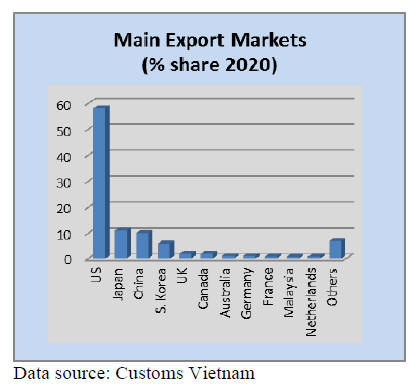
Imports
In 2020, W&WPs imported into Vietnam were valued at
US$2.558 billion showing a minor year-on-year growth of
0.6%.

W&WP imports by foreign enterprises
In 2020 the value of W&WP imported by foreign
enterprises reached US$1.045 billion, 35% up compared to
2019 and accounted for 41% of the total W&WP imports.
Main suppliers
In 2020, China continued as the largest W&WP supplier
for Vietnam accounting for US$862 million and a share of
34% of total imports.
Imports of W&WP from Thailand and Russia increased by
15% and 88% respectively compared to 2019. Conversely,
imports of W&WP from the US, Chile, Brazil, and France
declined compared to 2019.
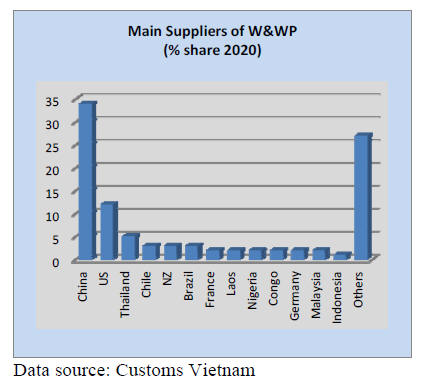
W&WP exports by key products, 2020
The top W&WP exported in 2020 included wood chips,
wood-based panels, wood pellets, chairs and wooden
furniture. Of these, peeled veneer grew at the highest rate,
increasing by 94% in volume and 51% in value, followed
by chairs with a growth of 32% in export value and
wooden furniture of 22% compared to 2019.
Wood pellet: Export volume 3.2 million tons,
valued at: US$352.03 million, 15% up in quantity
and 13% up in value against 2019.
Fibreboard: Export volume 111,200 cu.m, value
US$45.78 million, 28% down in volume and 1 %
in value against 2019
Peeled veneer: Export volume 694,230 cu.m,
value US$81.69 million, 94% up in volume and
51% up in value against 2019
Particleboard: Export volume 39,700 tons, value
US$9.5 million, 16% down against 2019
Plywood: Export volume 2.09 million cu.m,
value US$719.41 million, 0.2% down against
2019
Woodchips: Export volume 11.6 million tons,
value US$1.48 billion, 3% down in volume and
12% down in value against 2019
Chairs: Export value US$2.67 billion, 32% up
against 2019
Wooden furniture: Export value US$5.87 billion,
22% up against 2019
W&WP importss by key products, 2020
Key imported W&WP included logs, sawnwood,
fibreboard, and plywood. In 2020 imports of logs and
sawnwood declined while the imports of wood-based
panels increased.
Logs: Import volume 2.02 million cu.m, value
US$563 million
Fibreboard: Import volume 744,670 cu.m, 8% up
in volume and 2 % up in value against 2019
Sawnwood: Import volume 2.54 million cu.m,
value US$ 42.06 million, 9% down in volume
and 1% down in value against 2019
Particleboard: Import volume 434,720 cu.m,
value US$84.69 million, 16% up in volume and
7% up in value against 2019
Plywood: Imports 604,280 cu.m, 16% up in
volume and 6% up in value against 2019
Veneer: Imports 275,980 cu.m, value US$208.13
million, 27% up in volume and 9% up in value
against 2019
Chairs: Import value (HS 9401) US$ 163 million,
28% up against 2019
Wooden furniture: Import value (HS 9403) US$
187.95 million, 51% up against 2019
8. BRAZIL
Record low interest rate maintained
Inflation, as measured by the Broad National Consumer
Price Index (IPCA), was 0.25% in January 2021, 1.1%
down from December. Over the last 12 months inflation
came in at 4.56%. In January 2021 the Central Bank
decided to leave the basic interest rate (Selic) unchanged
at a record low of 2.00%.
Advances in development of technical standards
The process of development and updating technical
standards in Brazil involves discussion between
representatives of the production sector, regulatory
agencies, government and consumers.
One of the sectors that works intensively in this area is the
timber industry because products must be manufactured to
established standards which guarantee performance and
quality requirements for the consumer. The Brazilian
Association for Mechanically Processed Timber
(ABIMCI) has worked to advance updating and
development of new technical standards for wood
products.
In 2020, two parts of the standard (ABNT NBR 16864) for
sawnwood were published and now a standard for civil
construction, packaging and general timber use is under
discussion. Additionally, other standards such as “wood
preservatives” (ABNT NBR 16143) is being reviewed and
a text for a wood pellets standard is under preparation. The
most recently created Study Committee was charged with
developing a standard for film faced plywood.
Another standard under consideration in the wood and
civil construction sectors is for “light-frame wood
construction” (ABNT NBR 16936) a draft has been
submitted for national consultation.
ABIMCI expects that once the standard is agreed there
will be many business opportunities for wood products
manufacturers in this new construction system for housing
with the possibility of an increase in domestic
consumption.
Another standard directly linked to civil construction,
specifically related to wooden doors (ABNT NBR 15930 -
Part 3), has been drafted. The new standard includes
additional performance requirements such as wooden
soundproof doors, radiation protection doors and
emergency exits doors.
Amazon deforestation dropped in January
Deforestation alerts in the Legal Amazon in January 2021
were the lowest in the past four years, dropping of 70%
compared to January 2020. This information was released
by the Ministry of Defense and was based on data from the
National Institute for Space Research (INPE).
Between August 2020 and January 2021 there was a 988
sq. km reduction in deforestation alerts according to INPE.
The Ministry of Defense said that the data show the
success of work coordinated by the National Council of
the Legal Amazon in the region, mainly through the
Operation “Verde Brasil 2” (Green Brazil 2) to combat
environmental crimes in the Legal Amazon.
The Ministry of Defense explained that the Integrated
Group for the Protection of the Amazon (GIPAM) verifies
information available in the databases of environmental
protection and law enforcement agencies and produces
reports that detail where illegal deforestation has occurred.
Based on these reports, the operation “Verde Brazil” and
environmental agencies plan the action of the Armed
Forces and inspection teams.
Export update
In January 2021 Brazilian exports of wood-based products
(except pulp and paper) increased 22.8% in value
compared to January 2020, from US$206.6 million to
US$253.6 million.
Pine sawnwood exports dropped 6% in value between
January 2020 (US$37.5 million) and January 2021
(US$35.2 million). In volume, exports fell 8% over the
same period, from 207,700 cu.m to 191,000 cu.m.
Tropical sawnwood exports increased 7.2% in volume,
from 29,000 cu.m in January 2020 to 31,100 cu.m in
January 2021. In terms of value, exports grew almost 1%
from US$12.7 million to US$12.8 million, over the same
period.
Pine plywood exports saw a surge of 91% in value in
January 2021 in comparison with January 2020, from
US$26.4 million to US$50.3 million. In volume terms
exports increased 41% over the same period, from 121,000
cu.m to 170,400 cu.m.
As for tropical plywood, exports declined in volume (-
28.3%) but the value remained stable. Export earnings
US$1.8 million in January 2020 and US$ 1.8 million in
January 2021.
An encouraging increase in wooden furniture exports was
recorded in January with the value increased from
US$30.0 million in January 2020 to US$41.1 million in
January this year, a boost of 37% jump.
2020 export performance
In early February 2021, the Brazilian Association for
Mechanically Processed Timber (ABIMCI) published the
2020 export performance for wood products. With regard
to tropical plywood the volume shipped reached 101,720
cu.m., representing a 14% increase in relation to the
volume shipped in the previous year.
Tropical veneer exports in 2020 were 83,625 cu.m, an
increase over the previous year with Asia being the main
destination.
In 2020 exports of tropical sawnwood were 450,217 cu.m,
a 15% year on year decline. Vietnam was the main
destination for tropical sawnwood in 2020.
Tropical mouldings (profiled timber) followed the same
trend with a 7% decrease in the volume shipped compared
to 2019. Engineered wood flooring exports were
4,028,076 kg. down 29% over the previous year with the
United States being the main destination for the product.
For solid wood flooring the volume shipped reached
69,866,937 kg. an increase of approximately 27%
compared to the volume exported in the previous year.
The United States was the main market for this product.
As for the exports of wooden doors, the total exported in
2020 was 169,125,340 kg. representing a 30% growth in
relation to the amount shipped in the previous year. The
main exported type is solid wooden doors.
An overview of furniture exports
ABIMÓVEL, the Brazilian Association of Furniture
Industries, recently presented an overview of 2020
furniture exports by state. The states in the Southern
Region are the largest furniture exporters in Brazil.
Together, the states of Santa Catarina (41.3%), Rio Grande
do Sul (27.6%) and Paraná (14.9%) accounted for almost
85% of Brazilian furniture exports in 2020.
Despite the quite impressive performance exports from
Santa Catarina and Rio Grande do Sul declined compared
to 2019. In Santa Catarina there was a drop of US$5.9
million and in Rio Grande do Sul there was a drop of
US$16.2 million in exports. Paraná State, on the other
hand, experienced a growth in furniture exports of US$2.3
million.
In 2020 the states of Pará and Rio de Janeiro managed to
expand their share of exports but from a very low base.
2020 exports from Pará expanded 121% year on year
while the furniture industry in the state of Rio de Janeiro
exported 93% more in 2020 compared to a year earlier.
The export of furniture is an important employment sector
and provides significant opportunities regardless of the
size of the company and the segment in which it operates.
ABIMÓVEL is helping companies seize opportunities in
e-commerce and new logistical modalities. It supports
export promotion along with Apex-Brazil (Brazilian Trade
and Investment Promotion Agency).


9. PERU
Exports declined in 2020
The FOB value of semi-manufactured wood product
exports in 2020 totalled US$55.4 million representing a
year on year decline of 31%.
The main market for wood products in 2020 was China
which took just over half of all wood products but in 2020
there was a 36% decline in exports to China. The second
most important market for the semi-manufactured
products in 2020 was France with a 15% share of exports
but, as with China, exports to France fell year on year in
2020 dropping by a third.
Denmark was the third placed market in terms of export
value with an almost 9% share of exports and there was a
rise of around 7% in the value of 2020 exports compared
to a year earlier.
Exports of wooden furniture defy the trend
Exports of furniture and furniture parts in 2020 were worth
US$3.8 million FOB, just 3% below that in 2019. The
main markets were the US which accounted for around
75% of exports followed by Italy with a 9% share. The
value of exports of furniture and parts to these two
markets increased slightly in 2020.
Furniture manufacturers in Peru had to contend with many
disruptions throughout the year and most were operating
well below capacity.
Peruvian chipboard imports set a new record
In 2020, despite a sharp fall in the first half of the year
imports, Peru’s imports of composite panels were a record
US$108.9 million, up on 2019 by about 8%.
With an increase in shipments of 1.6% ( US$44.9 million,
2020, US$4.2 million2019) Ecuador was once again the
main shipper followed by Chile (US$23.7 million). Spain,
was the third placed shipper (US$21.9 million) up 27%
year on year. Producers in Brazil supplied composite
panels valued at US$15.1 million.
8 million hectares identified for restoration
The Ministry of Agrarian Development and Irrigation
(MIDAGRI) has been advised by the National Forest and
Wildlife Service (Serfor) that 8.2 million hectares of
degraded forest have been identified for restoration. Of
this, 2.2 million are in the Andean zone, 519,000 hectares
in the Amazon and 149,000 hectares along the coast.
The main issues identified with degraded forests is the loss
of natural vegetation cover, loss of biodiversity and
reduced of ecosystem services for water regulation.
There are also cases of grazing, pasture burning and forest
fires, land use change, inadequate water management and
deforestation.
The departments with the largest areas with a very high
priority for restoration are Ayacucho with 2.1 million
hectares, followed by Áncash with 1.9 million, Huánuco
with 1.7 million, Piura with 1.7 million and Cusco with
1.6 million hectares.
